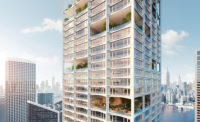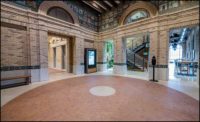Designing HVAC systems for energy-efficient mid- to high-rise hotels is an intricate endeavor, intertwining cutting-edge technology, engineering prowess, and an awareness of evolving industry standards and regulations. As energy demands continue to climb, the drive towards sustainable hotel design has become a priority. Engineers find themselves at the center of this transformation, tasked with balancing the sophisticated interplay of energy efficiency, performance, and guest comfort.
In this regard, understanding the differences between traditional and modern HVAC systems is crucial. The former often pose a higher risk of inefficiency and energy loss, while the latter incorporate advanced technologies, like artificial intelligence (AI), that optimize energy consumption, improve system control and enhance overall performance.
However, knowing about AI is not enough. Engineers need to fully grasp how to apply this potent technology within HVAC system control. Leveraging AI can lead to substantial energy savings, improved indoor air quality, and a superior guest experience.
Furthermore, a shift towards electrification in HVAC systems has become more prevalent. This transformation aligns with the global movement towards renewable energy, reducing the carbon footprint, and supports the universal aim of sustainable development.
This article will delve into some of these topics, providing insights into energy-efficient HVAC designs for hotels, touching on advanced technologies like AI, and exploring the potential of full electrification in HVAC systems. We will also examine a couple of HVAC system examples, shedding light on the complex and rewarding world of hotel HVAC design.
HVAC Options
The design of HVAC systems for medium to large hotels has traditionally prioritized substantial energy savings, a goal that hinges on the judicious selection and accurate sizing of HVAC equipment. However, this traditional approach, which often still relies on fossil fuels as the primary energy source, is progressively being considered outdated, particularly in the context of rising environmental concerns and the global push towards renewable energy sources.
In this traditional design framework, one of the key considerations has been to avoid the oversizing of chillers. This is because the efficiency of these units tends to degrade when they are underloaded, typically below the 40% threshold. For optimum energy efficiency, these chillers should ideally operate above the 50% loading mark for the majority of their operation time.
However, it's essential to note that even though these strategies can help achieve energy efficiency to some degree, they still essentially rely on fossil fuel-driven energy sources, which have substantial environmental implications. As the engineering community continues to seek more sustainable solutions, this approach represents an older strategy in the HVAC design process.
The new era of HVAC design for hotels now leans more towards the integration of renewable energy, electrification, and sophisticated control technologies like AI. The forthcoming examples represent this shift, highlighting the possibilities for environmentally conscious, efficient and highly controllable HVAC systems for the modern hotel industry.
Example 1: Air-Cooled Chillers, Hot Water Boilers and 4-Pipe Fan Coil Units
Figures 1 and 2 illustrate a conventional and practical HVAC system design used in many mid-sized hotels. This design effectively combines air-cooled chillers, hot water boilers, and 4-pipe fan coil units. The air-cooled chillers supply chilled water during the cooling season, while hot water boilers ensure a steady supply of hot water during the colder months. The 4-pipe fan coil units, equipped with both a heating coil and a cooling coil, allow for dual heating and cooling capabilities, facilitating precise temperature regulation throughout the hotel.


A critical factor in energy-saving design is the arrangement of chillers and boilers in a variable primary configuration. In this setup, the pumps push water through the chillers in a manner that varies with the cooling load, thus optimizing energy usage. The variable primary flow (VPF) system supersedes the traditional constant primary flow (CPF) system by eliminating the need for separate primary and secondary pumps. This results in reduced pump energy usage and allows for simpler, more compact mechanical room layouts, an attribute particularly valuable in hotel environments where space can be at a premium.
To ensure the building automation system (BAS) maintains the required minimum flow through each operating chiller, it's critical to include flow measuring devices in the design. A reliable method for measuring water flow in these systems involves the use of inline flow meters. These meters provide accurate, real-time flow data to the BAS, enabling it to effectively manage chiller operation in response to variations in demand.
Furthermore, the incorporation of a dedicated modulating control valve for each chiller aids in balancing equal flow through the operational chillers. Unlike basic on/off valves, modulating control valves can adjust to varying degrees of openness, providing more precise control over the flow of water.
A system bypass valve is another crucial component of the design, ensuring adequate flow through the chillers when there is minimal load in the building. The bypass valve routes water directly from the supply to the return side of the system, thereby helping to maintain the necessary flow rates through the chillers while preventing them from cycling on and off excessively under low load conditions.
By integrating these design elements — the use of inline flow meters, dedicated modulating control valves for each chiller, and a system bypass valve — HVAC systems in hotels can achieve greater energy efficiency and provide consistent, comfortable indoor environments for guests.
The hot water boilers, similar to the chillers, are arranged in a variable primary configuration as well. However, there is a crucial difference: in the boiler system, the pumps draw water through the boilers instead of pushing it.
Air-cooled chillers, apart from their energy-efficient features, have the added advantages of lower maintenance needs, obviating the requirement for a cooling tower, and being well-suited for scenarios where space is limited. On the other hand, hot water boilers are instrumental in providing consistent and reliable heat during the colder periods. The 4-pipe fan coil units offer the distinct advantage of individual control for different areas or rooms within the hotel, significantly contributing to enhanced guest comfort. Thus, this HVAC system design offers a practical, flexible, and energy-efficient solution for temperature regulation in mid-sized hotels.
A key component of the HVAC system design for mid-sized hotels is the Dedicated Outdoor Air System (DOAS). Serving all the rooms and common areas on the first floor, the DOAS provides fresh, conditioned air to improve indoor air quality, control humidity, and enhance overall occupant comfort.
The DOAS, in this context, can be a variable volume air handling unit, designed to adjust the flow of air based on occupancy or demand, further optimizing energy use. It is typically equipped with a hot water preheat coil, a chilled water coil, and a hot water reheat coil.
The hot water reheat coil is a critical component for managing humidity levels in the building. After the air is cooled and dehumidified by the chilled water coil, it might be too cold to be supplied directly into the rooms. The hot water reheat coil reheats this air to near room temperature, providing better control over the indoor humidity levels. This step is crucial to ensure the air supplied is close to room neutral dry bulb temperature, thus mitigating any risks associated with thermal discomfort.
By incorporating a DOAS with a hot water preheat coil, a chilled water coil and a hot water reheat coil, the HVAC system ensures optimal temperature and humidity control, thereby improving guest comfort, preserving the building's structural integrity, and contributing to overall energy efficiency.
Example 2: Cooling Towers, Backup Boilers and Water Source Heat Pumps
Another conventional and practical HVAC system design for large hotels often includes cooling towers, backup boilers, and water source heat pumps located in each hotel room and also in the common areas. Each of these components plays a vital role, and their interactions are key to the efficiency and effectiveness of the overall system.
In this setup, cooling towers are a fundamental element. Their main function is to remove excess heat from the system by dissipating it into the atmosphere. The heat extraction process occurs as a result of evaporative cooling, which lowers the temperature of the water in the system. This cooled water is then circulated back into the system and can be used to absorb heat from the rooms when the water source heat pumps are in cooling mode.

Water source heat pumps are at the heart of this system and provide individual heating and cooling to the rooms. These units transfer heat to or from a water source, which could be a cooling tower or boiler, depending on whether cooling or heating is required. This ability to offer personalized temperature control in individual rooms, combined with their inherent energy efficiency, makes these heat pumps an excellent choice for hotel environments.
Backup boilers become crucial when the heating demands of the water loop surpass the cooling needs, a situation that can occur even if some heat pumps within the loop are in cooling mode. This can often be the case in colder climates or during colder periods. When a large majority of the heat pumps in the loop are in heating mode, they extract heat from the water loop, causing a steady decrease in water temperatures. At this point, backup boilers step in to replenish the loop's heat, injecting additional heat into the water loop. This ensures the loop's temperature remains within the necessary range, enabling comfortable and consistent conditions to be maintained throughout the hotel, regardless of outside temperatures.
To maintain the integrity of the system, it's crucial to incorporate a heat exchanger (HX) between the tower loop and the building loop. The heat exchanger is instrumental in minimizing fouling of the heat pumps. Fouling, which refers to the build-up of impurities that can hamper heat transfer efficiency and potentially cause equipment damage, is a common concern in HVAC systems. The heat exchanger helps to manage water quality, thereby mitigating the risk of fouling and promoting both the efficiency and longevity of the system.
This HVAC system design includes dedicated water source heat pumps for the common areas, conference center and restaurant. These dedicated units ensure that the specific temperature and comfort requirements of these areas are met without affecting the performance of the HVAC system in individual rooms. This approach results in a robust and efficient HVAC system that meets the hotel's needs while minimizing energy consumption and maintenance requirements.
In this context, the configuration of the dedicated outdoor air system (DOAS) can take a couple of forms. One possibility is a standalone packaged direct expansion (DX) rooftop unit (RTU) with built-in dehumidification control, typically achieved through hot gas reheat. This setup offers the advantage of standalone operation, meaning it can function independently of other HVAC components, which can be beneficial for maintenance and system flexibility.
On the other hand, the DOAS could also be a water-cooled unit connected to the condenser water loop, located upstream of the building HX. While this option integrates well with the overall HVAC system and could offer operational efficiencies, it comes with its own set of considerations. For instance, the selection between these alternatives heavily depends on factors such as space availability, budget, and the unique requirements of the hotel.
A critical aspect to consider when opting for a water-cooled DOAS unit is the climate of the hotel location. This is particularly significant in colder climates where there might be a considerable span of time during the year when the need for cooling is virtually non-existent. In these colder periods, to conserve energy, it might seem feasible to shut down the condenser water system and run only the boilers. However, with a water-cooled DOAS, this cannot be implemented.
If the DOAS is a heat pump type DX unit, it requires a continuous supply of condenser water for its operation, even during colder months when the rest of the system might not need cooling. This requirement can present a constraint on system flexibility and efficiency, potentially leading to increased energy usage during periods of low cooling demand. Hence, it's vital to account for such factors when designing the HVAC system to ensure a balance between operational efficiency, energy savings and indoor comfort.







